

Bullying Definition. Bullying is unwanted, aggressive behavior among school aged children that involves a real or perceived power imbalance.
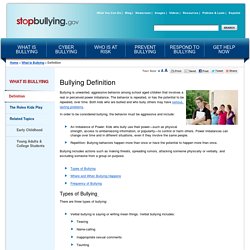
The behavior is repeated, or has the potential to be repeated, over time. Both kids who are bullied and who bully others may have serious, lasting problems. In order to be considered bullying, the behavior must be aggressive and include: An Imbalance of Power: Kids who bully use their power—such as physical strength, access to embarrassing information, or popularity—to control or harm others.
Power imbalances can change over time and in different situations, even if they involve the same people. Bullying includes actions such as making threats, spreading rumors, attacking someone physically or verbally, and excluding someone from a group on purpose. P21. Information Literacy. Access and Evaluate Information Access information efficiently (time) and effectively (sources)Evaluate information critically and competentlyUse and Manage InformationUse information accurately and creatively for the issue or problem at handManage the flow of information from a wide variety of sourcesApply a fundamental understanding of the ethical/legal issues surrounding the access and use of information Additional resources: 1.
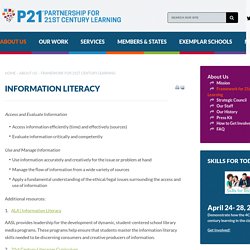
Media Literacy. Analyze MediaUnderstand both how and why media messages are constructed, and for what purposesExamine how individuals interpret messages differently, how values and points of view are included or excluded, and how media can influence beliefs and behaviorsApply a fundamental understanding of the ethical/legal issues surrounding the access and use of mediaCreate Media ProductsUnderstand and utilize the most appropriate media creation tools, characteristics and conventionsUnderstand and effectively utilize the most appropriate expressions and interpretations in diverse, multi-cultural environments Additional resources: 1.
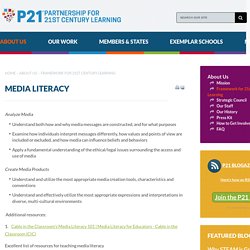
Cable in the Classroom's Media Literacy 101 | Media Literacy for Educators - Cable in the Classroom (CIC) Excellent list of resources for teaching media literacy 2. Usingeducationalvideointheclassroom. Copyright, What's Copyright? Copyright & Creative Commons for Kids. Cb copyright. Taking the Mystery Out of Copyright. Skip navigation Library of Congress Teachers Suggestions enabled.
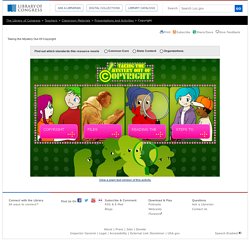
The Library of Congress > Teachers > Classroom Materials > Presentations and Activities > Copyright Print Subscribe Share/Save Give Feedback Taking the Mystery Out Of Copyright View a plain text version of this activity. Connect with the Library All ways to connect. Questia How To Avoid Plagiarism Video: Avoiding plagiarism, second deadly sin of paper writing.
Funny but teaches about Plagiarism. Protecting Personal Information by angi.holden. Identity Theft. Methods According to the Federal Trade Commission (FTC), identity thieves can obtain information by rummaging through trash or stealing from purses, wallets, mailboxes, or homes.[1] They may also use electronic methods, such as those listed below.
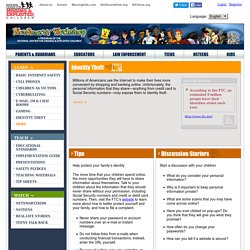
Phishing relies on pop-ups, spam, and websites that look authentic to obtain personal information, such as log-in information and credit card numbers. Pharming uses malicious code to redirect users to fraudulent sites where hackers can access their personal information. Pretexting acquires personal information through false and illegal means, for example, obtaining financial information by pretending to call from a bank. These scams are sometimes accomplished with the use of malware (software designed to damage computers). NSTeens.org - Making Safer Choices Online. Making Safer Choices Online. Stay Safe - NetSafe Utah. 1) Acceptable Use Policies (AUP) AUP's are "contracts" that outline how students can use the technology, what they cannot do with it and the consequences for violating the policy.

These should include school web pages and the content that is allowed on them. AUPs should be signed by an authorized representative of the school, students and parents so that all concerned parties are aware of the policy. 2) No Student Names It is recommend that when referring to students on a web page that either their names not be used or only their first names be posted. 3) Student Pictures You are encouraged to post student work that may include student pictures; however, you should get written permission to post student pictures and work before placing it onto the web.
Personal Information - NetSafe Utah. After watching the Protect Your Personal Information video see how well you do on the following questions: Q: What are examples of private personal information?
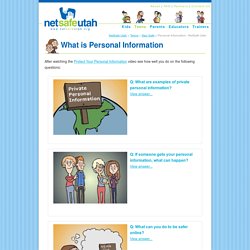
A: Passwords, credit card info, what school you attend, what grade you are in, name, address, E-mail, phone number, and pictures. Stay Safe - NetSafe Utah. Trusted Adults - NetSafe Utah. After watching the Trusted Adults Can Help You video see how well you do on the following questions: Q: What do you do if you're searching the internet and see something that makes you feel uncomfortable?

A: Tell an adult you trust. Together you can learn how to do searches online that help you to avoid stuff that you don't want to see. Talk to an Adult - NetSafe Utah. Parents Presentation. Title CloseX About Us Donate MissingKids.com NetSmartzKids.org NSTeens.org Language: Login Register Parents Presentation Download Presenter's Guide Learn Teach Watch.
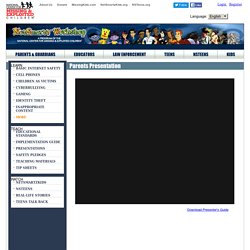
Tweens Presentation. Title CloseX About Us Donate MissingKids.com NetSmartzKids.org NSTeens.org Language: Login Register.
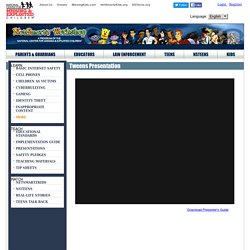
Teens Presentation. Title CloseX About Us Donate MissingKids.com NetSmartzKids.org NSTeens.org Language: Office of the Children's eSafety Commissioner. Children's Online Privacy Protection. How to comply with Children's Online Privacy Protection Act The Children's Online Privacy Protection Act, effective April 21, 2000, applies to the online collection of personal information from children under 13. The new rules spell out what a Web site operator must include in a privacy policy, when and how to seek verifiable consent from a parent and what responsibilities an operator has to protect children's privacy and safety online.
The Federal Trade Commission staff prepared this guide to help you comply with the new requirements for protecting children's privacy online and understand the FTC's enforcement authority. A Tale of Two Footprints. Definition Of Digital Citzenship. The Definition Of Digital Citizenship by Terry Heick As more and more students interact digitally–with content, one another, and various communities–the concept of digital citizenship becomes increasingly important. Which begs the question: what is digital citizenship? Well, first citizenship, which is formally defined as “the quality of an individual’s response to membership in a community.” Teacher's Guide to Digital Citizenship. The horror stories of young people not grasping the reach and influence of the content they put online are familiar to all of us. From the loss of job opportunities due to unprofessional pictures or comments on social media, to the more serious threats of abduction, and even the self-harm inspired by cyber bullying, the stakes are high.
While students may often seem clueless to these dangers, some are starting to understand the risks. In a recent Rasmussen study on digital literacy, details of which you can see in the infographic below, 37% of millennials aged 18 – 34 said they consider the internet scary, which is more than any other demographic. Still, millennials know just as well as any other demographic just how important digital literacy is and will continue to be to their working lives. As such, studies like these serve to demonstrate how crucial teaching digital literacy — particularly at a young age when that digital footprint is still lightly drawn — has become. The Password Rap. Copyright © 2001-2016 National Center for Missing & Exploited Children. All rights reserved. Animated Characters Excluding Tera Copyright © 2000-2016 National Center for Missing & Exploited Children and Boys & Girls Clubs of America.
All rights reserved. This Web site is funded, in part, through a grant from the Office of Juvenile Justice and Delinquency Prevention, Office of Justice Programs, U.S. Department of Justice.